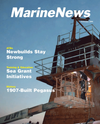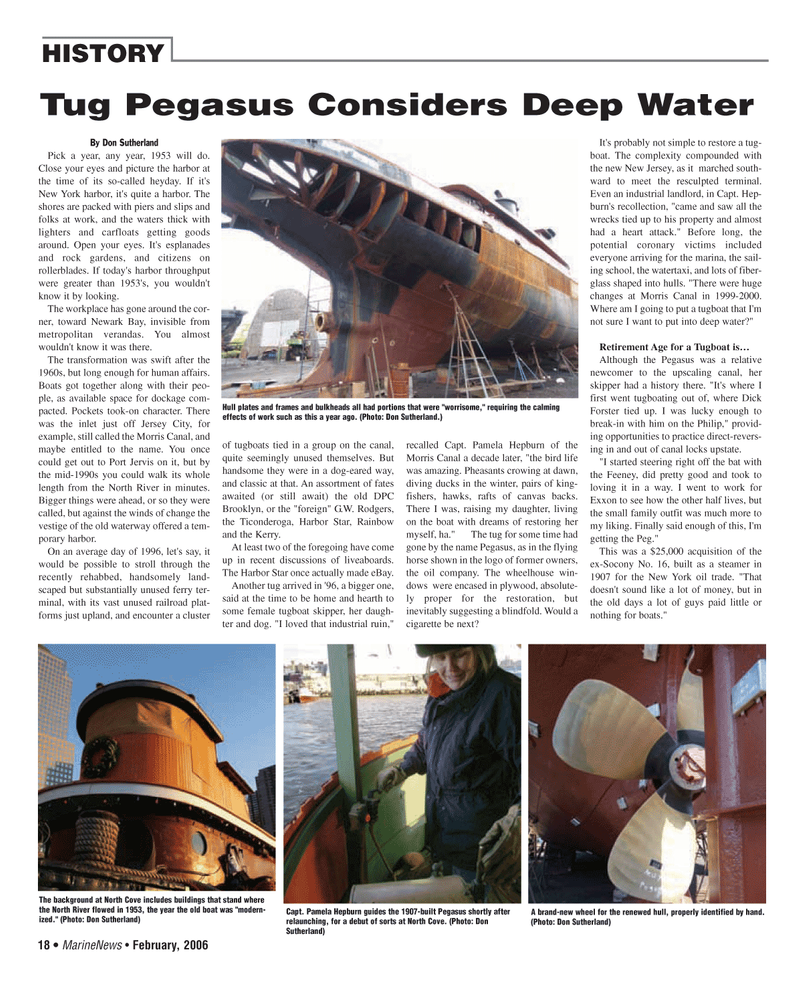
Page 18: of Marine News Magazine (February 2006)
The Training & Education Edition
Read this page in Pdf, Flash or Html5 edition of February 2006 Marine News Magazine
18 • MarineNews • February, 2006
By Don Sutherland
Pick a year, any year, 1953 will do.
Close your eyes and picture the harbor at the time of its so-called heyday. If it's
New York harbor, it's quite a harbor. The shores are packed with piers and slips and folks at work, and the waters thick with lighters and carfloats getting goods around. Open your eyes. It's esplanades and rock gardens, and citizens on rollerblades. If today's harbor throughput were greater than 1953's, you wouldn't know it by looking.
The workplace has gone around the cor- ner, toward Newark Bay, invisible from metropolitan verandas. You almost wouldn't know it was there.
The transformation was swift after the 1960s, but long enough for human affairs.
Boats got together along with their peo- ple, as available space for dockage com- pacted. Pockets took-on character. There was the inlet just off Jersey City, for example, still called the Morris Canal, and maybe entitled to the name. You once could get out to Port Jervis on it, but by the mid-1990s you could walk its whole length from the North River in minutes.
Bigger things were ahead, or so they were called, but against the winds of change the vestige of the old waterway offered a tem- porary harbor.
On an average day of 1996, let's say, it would be possible to stroll through the recently rehabbed, handsomely land- scaped but substantially unused ferry ter- minal, with its vast unused railroad plat- forms just upland, and encounter a cluster of tugboats tied in a group on the canal, quite seemingly unused themselves. But handsome they were in a dog-eared way, and classic at that. An assortment of fates awaited (or still await) the old DPC
Brooklyn, or the "foreign" G.W. Rodgers, the Ticonderoga, Harbor Star, Rainbow and the Kerry.
At least two of the foregoing have come up in recent discussions of liveaboards.
The Harbor Star once actually made eBay.
Another tug arrived in '96, a bigger one, said at the time to be home and hearth to some female tugboat skipper, her daugh- ter and dog. "I loved that industrial ruin," recalled Capt. Pamela Hepburn of the
Morris Canal a decade later, "the bird life was amazing. Pheasants crowing at dawn, diving ducks in the winter, pairs of king- fishers, hawks, rafts of canvas backs.
There I was, raising my daughter, living on the boat with dreams of restoring her myself, ha." The tug for some time had gone by the name Pegasus, as in the flying horse shown in the logo of former owners, the oil company. The wheelhouse win- dows were encased in plywood, absolute- ly proper for the restoration, but inevitably suggesting a blindfold. Would a cigarette be next?
It's probably not simple to restore a tug- boat. The complexity compounded with the new New Jersey, as it marched south- ward to meet the resculpted terminal.
Even an industrial landlord, in Capt. Hep- burn's recollection, "came and saw all the wrecks tied up to his property and almost had a heart attack." Before long, the potential coronary victims included everyone arriving for the marina, the sail- ing school, the watertaxi, and lots of fiber- glass shaped into hulls. "There were huge changes at Morris Canal in 1999-2000.
Where am I going to put a tugboat that I'm not sure I want to put into deep water?"
Retirement Age for a Tugboat is…
Although the Pegasus was a relative newcomer to the upscaling canal, her skipper had a history there. "It's where I first went tugboating out of, where Dick
Forster tied up. I was lucky enough to break-in with him on the Philip," provid- ing opportunities to practice direct-revers- ing in and out of canal locks upstate. "I started steering right off the bat with the Feeney, did pretty good and took to loving it in a way. I went to work for
Exxon to see how the other half lives, but the small family outfit was much more to my liking. Finally said enough of this, I'm getting the Peg."
This was a $25,000 acquisition of the ex-Socony No. 16, built as a steamer in 1907 for the New York oil trade. "That doesn't sound like a lot of money, but in the old days a lot of guys paid little or nothing for boats."
Tug Pegasus Considers Deep Water
HISTORY
The background at North Cove includes buildings that stand where the North River flowed in 1953, the year the old boat was "modern- ized." (Photo: Don Sutherland)
Hull plates and frames and bulkheads all had portions that were "worrisome," requiring the calming effects of work such as this a year ago. (Photo: Don Sutherland.)
Capt. Pamela Hepburn guides the 1907-built Pegasus shortly after relaunching, for a debut of sorts at North Cove. (Photo: Don
Sutherland)
A brand-new wheel for the renewed hull, properly identified by hand. (Photo: Don Sutherland)
FEBRUARY MN2006 3(17-24).qxd 2/3/2006 4:39 PM Page 18

 17
17

 19
19
